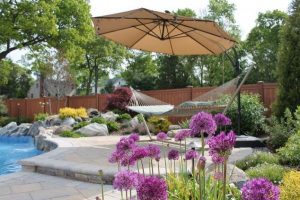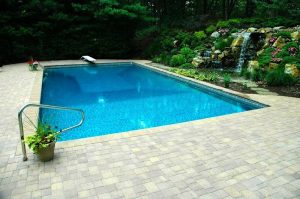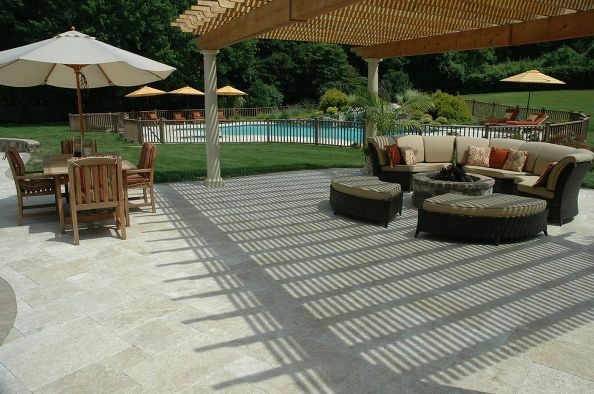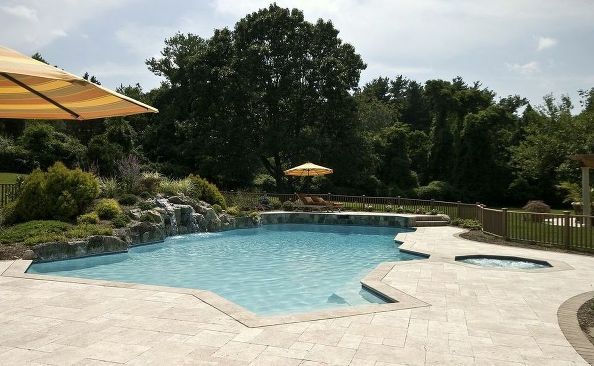Landscaping Trends: Purple Is ‘the’ Color for 2018
Purple is seen everywhere these days.
Ultra Violet is Pantone’s 2018 color of the year.
And from hair color, eye shadow and clothing, purple is taking center page in style magazines: People, InStyle and Essence to name but a few.
Not to mention, Rihanna, a true style icon, has been seen wearing lovely lavender shadow to accent her eyes.
So. It’s not surprising that one of HGTV’s top garden trends for 2018 is purple plants.
And we’ve got a few ideas today to help you choose bright pops of purple that can be planted throughout the 2018 season — beginning this spring.
Spring Purple.
1. Salvia Sylvestris May Night
Blooming in late spring, perennial Salvia Sylvestris May Night (May Night Meadow Sage), seen here in the right foreground, boasts deep purple-blue blooms.
The good news for gardeners in our Long Island, NY, area is how hardy this beauty is for our area of the Northeast because it claims superb cold hardiness, is a vigorous plant, and is tolerant of heavy clay soils.
If the robust color isn’t enough to make you rush to pick up some of these Salvias, consider: these plants attract butterflies and hummingbirds, and are deer and rabbit resistant. They make glorious cut flowers for inside and they bloom more than 4 weeks.
2. Soapwort
Another easy to grow stunner for spring is Soapwort. It’s also called Bouncing Bet which is a clue on how prolific it is.
It prefers full drainage and full sun and if you have a wall or trellis, it’ll make a home there.
It’s also available in low ground cover form that spreads nicely and is ideal around a water feature: stream, pond or waterfalls.
Its family name is Saponaria officinalis and offers good cut flowers.
Summer Purple.
1. Verbana
Available in annual and perennial varieties (a total of 250 varieties in fact), this stunning flora is at its best during the hottest of summer heat.
With so many varieties, it’s a cinch to find a glorious purple specimen for your garden.
Often used in herbal teas, it’s beloved by more than humans. Yup. Butterflies and hummingbirds adore its blooms as well.
2. Purple Allium
Although planted in fall, the Purple Allium Sphaerocephalon seen in the foreground of this Deck and Patio project is a summer blooming delight.
Its robust color thrives beautifully on Long Island and in the Northeast in general.
Deck and Patio landscape designers chose the Purple Allium for its height, as well as the lovely color contrast it made against the green and yellows around it.
The plants first open green, and then mature to a bright crimson-purple. More good news. It’s rabbit, deer and rodent resistant and is loved by pollinators.
Autumn Purple.
1. Aster
The Purple Dome Aster (novae-angliae) is a beautiful autumn plant that blooms from late summer in to autumn.
It is a dwarf variety of the more common New England Aster. And as you can see from the photo, it makes a wonderful impact as an accent among fall grasses.
Needless to say it can be cut for beautiful indoor bouquets. Indeed, there’s lots to cut as these plants boast masses of daisy-like deep purple flowers. They also have a sunny yellow center.
These beauties will bloom for over 4 weeks in fall; in spring and early summer they show off gray-green leaves. These disappear under the royal purple daisies in fall.
Autumn/Winter Purple.
1. Callicarpa dicotomía (Purple Beautyberry)
The Callicarpa dichotoma or purple beautyberry shrub’s colorful purple berries are a treasure in winter. They begin to bud in fall and last throughout winter.
The shrubs grow up to 4 feet tall. The branches boast pinkish to light purple flowers in summer which mature to these delightful berries in autumn.
These plants accept full sun and partial shade, which is good news. It gives you more options for planting and are not very demanding when it comes to growing conditions.
So as your starved eyes search for color in winter, your beautyberries, in bright purple, will satisfy that need. Do any pruning in late winter, just before spring. And as for your winter birdies — they’ll eat some of the purple berries.
And as a last little gift to our readers:
We all know what makes a purple garden grow: a little Purple Rain.
Now it’s Prince, after all, so you’ll have to be a little patient for the video to begin (at about 1.08 mins). But oh, his Purple Rain. Enjoy!
(Note: Our feature photo at the top of the page is the annual Globe Amaranth. Its bright pom-poms last well into the fall.)



























